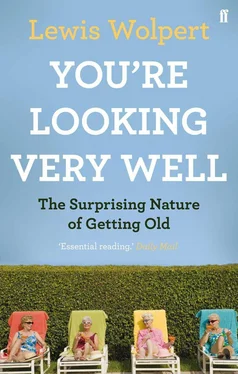David Willetts, the current science and education minister, has argued that the baby boom of 1945–65 produced the biggest, richest generation that Britain has ever known. Today, at the peak of their power and wealth, baby boomers, he claims, run our country; by virtue of their sheer demographic power, they have fashioned the world around them in a way that meets all of their housing, healthcare and financial needs at the expense of their children. Social, cultural and economic provision has been made for this reigning section of society, whilst the needs of the next generation have taken a back seat. But it is the old who will have the greatest impact.
Some analyses suggest that improvements in health and longevity have resulted in enormous gains in economic welfare. One estimate of the economic impact of post-1970 gains in life expectancy suggested that they might have added as much as 50 per cent to the GDP of the US. Even so, there are profound economic problems to be tackled.
The Economist has called the economic effect of an ageing population a slow-burning fuse. It claims that age-related spending by a country like the UK will in the future be more serious than the recent recession. The elderly require money for pensions, health and care. The age-related spending by the government in the UK is already about £ 7 billion, less than 1 per cent of GDP, but it clearly needs to rise. Already there are billions of pounds of benefits for the old which are not claimed. The last years of life can cost tens of thousands of pounds and this increases with advanced age. In many cases the cost of the last year of life is more than all that has been spent in earlier years. Forcing older workers to retire cost the UK in 2009 an estimated £ 3.5 billion in lost economic output. Pension plans, social security schemes and notions of the length of working lives will need to undergo major reformulation.
The small increases over time in average life expectancy that lead to very large increases in the size of a population are prompting many arguments. Reproductive practices might have to change in order to keep the population from becoming too large. In regard to the escalating costs of looking after the old, one group in the US has suggested there should be cuts to protect the young. It has been argued that any technological advances in life extension must be equitably distributed and not restricted to a privileged few. There are suggestions that the UK will become a giant residential home, with the young looking after the old. With family ties weakened by increased mobility and rising divorce, in the future the elderly will be less likely to be married or co-habiting, and more will live alone; and since they do not want to leave their homes it will hard for the young to find one to buy.
Such concerns were presented by Jeremy Lawrence, writing in the Independent , who described the ageing population as the greatest threat to human society: ‘No invading army, volcanic eruption or yet undreamt of plague can rival ageing in the breadth or depth of its impact on society… The impact of this transformation will be felt in every area of life, including economic growth, labour markets, taxation, the transfer of property, health, family composition, housing and migration. And the “demographic agequake” is already under way.’
The countries with the oldest populations—that is with the highest percentage over 65—are Monaco, then Italy and then Japan. The median age of the world population will, in the next 40 years, go from 28 to 38. The United States is on the brink of a longevity revolution. The elderly comprise 12 per cent of the US population, and their number is projected to almost double between 2005 and 2030, from 37 million to 70 million. By 2030, the proportion of the US population aged 65 and older will double to about 71 million older adults, or one in every five Americans. The far-reaching implications of the increasing number of older Americans and their growing diversity will include unprecedented demands on public health, ageing services and the nation’s healthcare. Although there may be unjustifiably pessimistic views of what is before us, an ageing population does present severe problems. But there are also great advantages.
* * *
An analysis of the consequences of increasing life expectancy must include the economic implications of changed population age structures, especially changes in the ratio of those in the labour force to those outside it, mainly children and elderly, which is known as the support ratio. In the early stages in which life expectancies rise, the proportion of the population within the labour force age range rises significantly, providing a substantial boost to economic growth. However, as people live longer those extra years will have to be financed, and there are only a limited number of ways to do this. These include working longer, increasing social security or other taxes, increasing immigration, and reducing consumption.
In order to reap the economic benefits of longer lives, some of the extra years of life will probably have to be spent working productively. In the UK one in five over the age of 55 can expect to work till they are 70 and even older. This is because of their limited finance. At 55 many still have a mortgage and less than £ 2,000 in savings. There is considerable variation in the EU about attitudes to the extension of working life—9 out of 10 in the Netherlands, Denmark, and Finland are positive, but in Greece, Portugal, Spain and Hungary they are not at all keen. It may be sensible to compensate younger people for working when they are older by allowing them to work fewer hours per week over the whole course of their lives.
The number of people supporting pensioners is decreasing, and it will go from four workers for each pensioner at present to two workers for every pensioner in 2050. A major problem of the ageing of societies is that people are having fewer children. The current global average is 2.6 children per woman, while in rich countries it is 1.6. One reason is that women are having babies later in life. This means that in some rich countries the population is beginning to decrease. In ageing countries, the economy can shrink as more retire and there are fewer young to take their place, and the older workers may be less productive. Japan has a very low ratio of workers to pensioners, just three to one, and by 2050 the number will probably halve. Such changes can reduce economic growth significantly. In some countries immigration is filling this labour gap; another solution is to encourage people to have more children, as has been done in France and Japan. There is also the problem of finding enough young adults for the armed forces.
Pensions raise serious economic issues. The official retirement age for most developed countries has remained the same even though the population is ageing. Many have even retired before the official retirement age. Retirement pensions are the largest component of age-related spending, and the cost of state pensions in rich countries will probably double by 2050 and reach more than 15 per cent of GDP. Payments to the pensions of retired civil servants in the UK which are based on final salary are very expensive—the pensions can be as large as two thirds of final salary. Each one-year increase in longevity increases costs £ 1.3 billion a year.
Part of the problem is that men can now look forward to between 14 and 24 years in retirement, much more than anticipated. Older workers also want a less onerous workload. The UK government’s decision to abolish the compulsory retirement age, currently 65, wll increase the number of the workforce. Retiring later will help financially, but will not the young then be deprived of senior appointments? It is estimated that unless urgent action is taken there will be a £ 6 billion hole in the funding of social care within 20 years. Free care at home could cost the state more than £ 1 billion. A very big financial hole is being opened up.
Читать дальше












